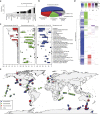Aquatic metagenomes implicate Thaumarchaeota in global cobalamin production
- PMID: 25126756
- PMCID: PMC4303638
- DOI: 10.1038/ismej.2014.142
Aquatic metagenomes implicate Thaumarchaeota in global cobalamin production
Abstract
Cobalamin (vitamin B12) is a complex metabolite and essential cofactor required by many branches of life, including most eukaryotic phytoplankton. Algae and other cobalamin auxotrophs rely on environmental cobalamin supplied from a relatively small set of cobalamin-producing prokaryotic taxa. Although several Bacteria have been implicated in cobalamin biosynthesis and associated with algal symbiosis, the involvement of Archaea in cobalamin production is poorly understood, especially with respect to the Thaumarchaeota. Based on the detection of cobalamin synthesis genes in available thaumarchaeotal genomes, we hypothesized that Thaumarchaeota, which are ubiquitous and abundant in aquatic environments, have an important role in cobalamin biosynthesis within global aquatic ecosystems. To test this hypothesis, we examined cobalamin synthesis genes across sequenced thaumarchaeotal genomes and 430 metagenomes from a diverse range of marine, freshwater and hypersaline environments. Our analysis demonstrates that all available thaumarchaeotal genomes possess cobalamin synthesis genes, predominantly from the anaerobic pathway, suggesting widespread genetic capacity for cobalamin synthesis. Furthermore, although bacterial cobalamin genes dominated most surface marine metagenomes, thaumarchaeotal cobalamin genes dominated metagenomes from polar marine environments, increased with depth in marine water columns, and displayed seasonality, with increased winter abundance observed in time-series datasets (e.g., L4 surface water in the English Channel). Our results also suggest niche partitioning between thaumarchaeotal and cyanobacterial ribosomal and cobalamin synthesis genes across all metagenomic datasets analyzed. These results provide strong evidence for specific biogeographical distributions of thaumarchaeotal cobalamin genes, expanding our understanding of the global biogeochemical roles played by Thaumarchaeota in aquatic environments.
Figures



References
-
- Bertrand EM, Saito MA, Rose JM, Riesselman CR, Lohan MC, Noble AE, et al. Vitamin B12 and iron colimitation of phytoplankton growth in the Ross Sea. Limnol Oceanogr. 2007;52:1079–1093.
-
- Bertrand EM, Saito MA, Jeon YJ, Neilan BA. Vitamin B12 biosynthesis gene diversity in the Ross Sea: the identification of a new group of putative polar B12 biosynthesizers. Environ Microbiol. 2011;13:1285–1298. - PubMed
Publication types
MeSH terms
Substances
LinkOut - more resources
Full Text Sources
Other Literature Sources
Molecular Biology Databases

